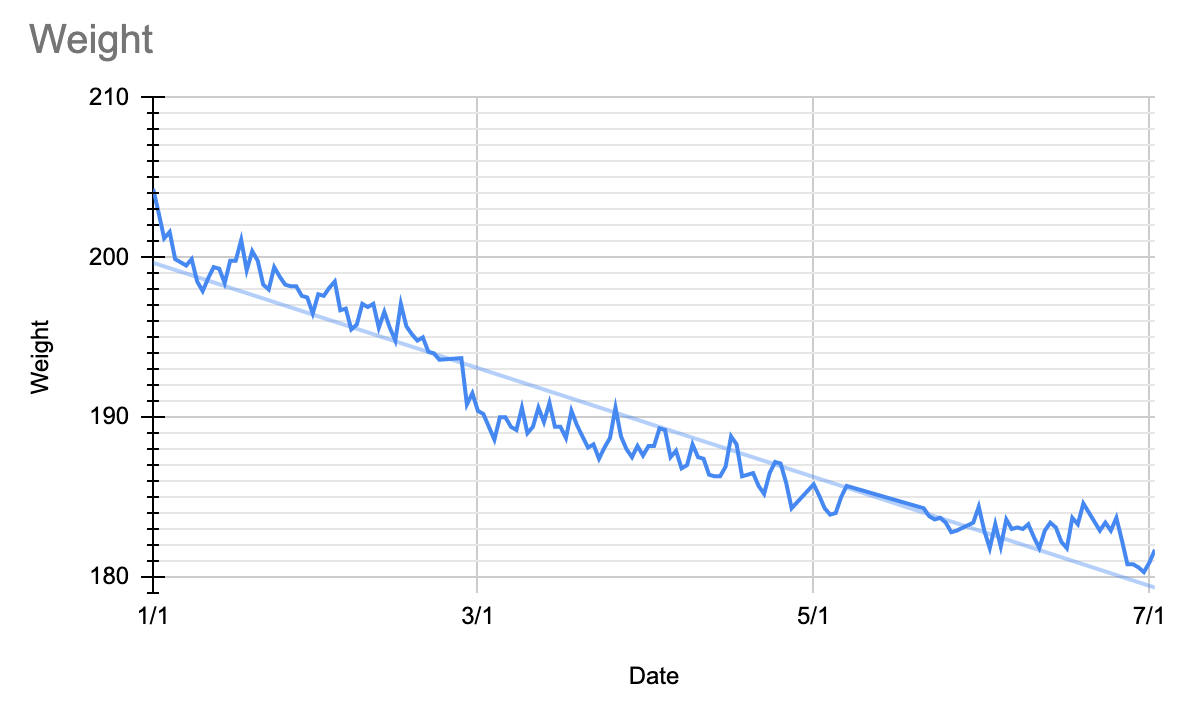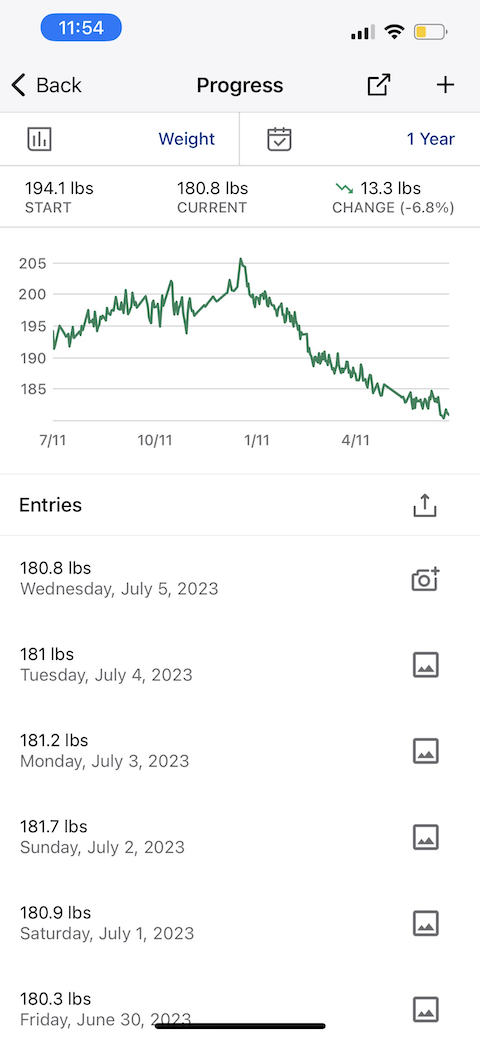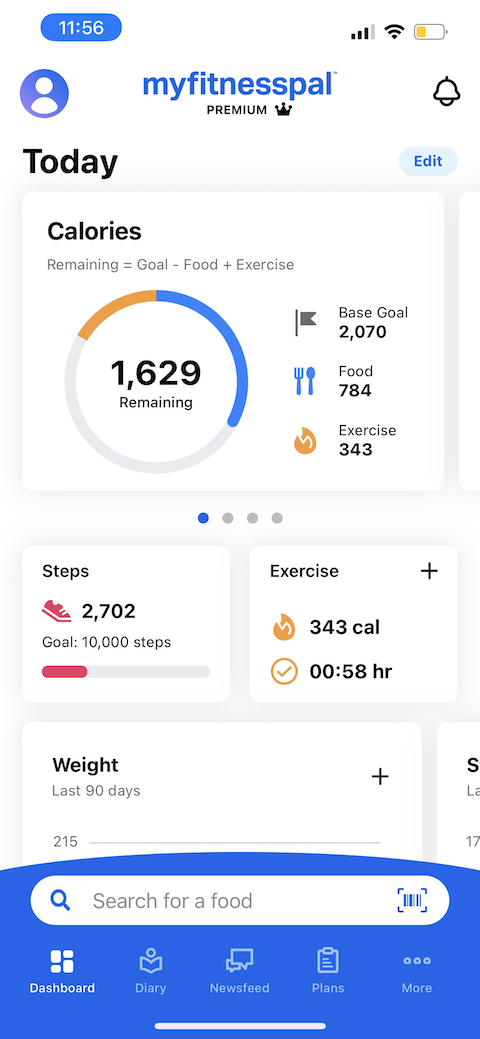Simple path to weight loss
Are you tired of endless diets, complex workout regimens, and conflicting advice on your quest to shed those extra pounds? Weight loss doesn’t have to be overwhelming or complicated. It’s all about calories in and calories out.
My path to weight gain and weight loss
At the end of last year, after becoming Ironman I was roughly 10-15 lbs overweight. I was overeating on purpose to don’t get sick while training. With a full-time job, I didn’t have enough time to work, live, train, and rest enough. I assumed that food will compensate for lack of rest, and help with immunity. It worked. I didn’t get sick.
After Ironman I went for a week to Hawaii where I had way too much of Hula pie. On top of all that, there was Christmas food, and I got sick for over a month. None of these helped with weight. I gained another 5-10 lbs, which put me at 20-25 lbs overweight. I’ve never been so much overweight in my life.
I decided to make my weight a priority, and over the last 6 months, I lost almost 25 lbs. This put me at my optimal weight.
I didn’t use any rocket science diet. I ate moderately healthy, and I didn’t eat too much. I counted how many calories I consumed, and how many I burned. I also exercised, as that’s part of my routine now. I used a spreadsheet to keep track of everything.

How many calories you can eat per day
To find out how many calories you need daily you need to know your Basal Metabolic Rate (BMR). You can use Free BMR Calculator to find that out.
For 6ft tall, and ~181 lbs male it is 1,799 Calories/day. That means that if you don’t do anything, but lie in bed, you need 1,799 Calories/day. You are usually moving, and doing things, thus your calorie intake needs to be higher. The BMR calculator provides estimates of how much more you need based on your activity level:
| Activity Level | Calorie |
|---|---|
| Sedentary: little or no exercise | 2,159 |
| Exercise 1-3 times/week | 2,474 |
| Exercise 4-5 times/week | 2,636 |
| Daily exercise or intense exercise 3-4 times/week | 2,788 |
| Intense exercise 6-7 times/week | 3,103 |
| Very intense exercise daily, or physical job | 3,418 |
I recommend using the sedentary value and measuring calories burned during your workouts separately.
You can measure how many calories you burn during the entire day with Oura Ring. I recommend Oura Ring also for sleep tracking. It’s the best device on the market. Sleep is an important part of keeping your weight, health and fitness intact. If you want to learn why, read Why We Sleep.
My approach for calculating my calorie budget was to use the Sedentary value as a base and add the calories I burn during workouts. I use a Garmin watch and Heart-Rate Monitor for that. I also used Oura Ring total calories burn to cross-check the values.
Counting Calories
To burn 1 pound, you need to develop a deficit of 3500 Calories. Do not try to lose more than 1 pound per week, as it will cause undesired side effects like exhaustion, tiredness, and the yoyo effect later on. 1 pound per week is still not bad: you can lose 4 pounds over 1 month, and 26 pounds in half a year.
Sorry, losing all 10-20 lbs in 1 month is not sustainable. Many people fall into that trap, and they quickly regain the weight.
To count calories, I recommend MyFitnessPal. A premium subscription allows you to scan the bar code from foods, which will automatically log calories and all nutrients.
You can connect MyFitnessPal to your smart scale and track your progress daily. You can also connect with Garmin or Strava to automatically count calories burned during workouts.
I also recommend keeping track of calorie deficit with a spreadsheet.
 |
 |
 |
Counting calories itself results in eating less. When you don’t know how many calories you ate, you may think that you need more food. Just being aware that you ate enough can trick your brain into craving less.
Healthy eating with chocolate and ice cream
When I started caring for my weight for the first time, a few years ago, I decided that I need to figure out a sustainable diet, which I’ll be able to maintain throughout my entire life.
Many people want to go through torture, and just lose all additional weight in 1 month. Unfortunately, after that, they go back to old eating habits, and their weight is back. This results in demotivation and unwillingness to pick up that challenge again.
It’s important to keep a good balance of carbs, protein and fats. Ideally about 50% carbs, 30% protein and 20% fat. If you don’t do that, you will end up hungry, and tired. Not keeping this balance is the main reason for weight gain. Eating pasta, which has a lot of carbs is causing the total calorie count to go up, but macros are out of balance. Your body still needs protein. Usually, people overeat carbs and fats but undereat protein. They reach the needed amount of protein by simply eating too many calories, or they don’t at all.
I often struggle with reaching my protein goals per day. It is helpful to use protein powder for that purpose. I add it to yogurt with blueberries or oatmeal if I have it for breakfast.
I love chocolate, and I like some not very-healthy foods like burgers, pizza, ramen, etc. It is fine to eat these foods, but in moderation, or occasionally. The most important thing is to balance macros. If you had a chicken salad (high protein) for lunch, you can have ramen (high carbs) for dinner.
The key is to treat the calories you consume like the money you spend. There are some good and bad investments.
Sample “bad investment foods”:
- 1 slice of cheese has ~100 kcal and a lot of fat
- 1 tbsp of mayo has 90 kcal while ketchup or mustard has only 20-40
- This small chocolate chip cookie at Starbucks is 360 kcal!
- Starbucks’ double chocolate brownie is 480 kcal!
Everyone is a human, and we need some treat from time to time. Even daily! The key is to be aware of how much each treat costs calorie-wise. Eat only delicious sweets. Don’t eat “meh” and “ok” sweets!
I prefer 2 Snickers bars (220 kcal each) over IMO average tasting brownie.
Another strategy is to don’t eat sweets for a few days and have a feast once or twice a week.
When I want to eat something, I always ask myself: “Is it worth that many calories or I would rather eat something better?”.
Watch out for the sugar intake. Any sugar you eat, when you don’t exercise, goes into your sides. The best time to eat sugar is before or during exercise.
Healthy and quick-to-make foods
- Unsweetened oatmeal with blueberries and protein powder
- 2-3 eggs (soft-boiled or scrambled in olive oil with onion), Ezkiel Bread with cream cheese, tomatoes and cucumbers
- Instant Pot chicken and rice
- chicken salad
- turkey burgers
- Fage 0% fat yogurt with fruits (blueberries/strawberries/raspberries) and protein powder (most yogurts have a lot of sugar - don’t eat that)
What to avoid
- Foods with high saturated fats
- deep fried foods
- sugary drinks like Coke, Frapuccino from Starbucks, pina coladas, etc.
- alcohol - when alcohol enters the body, it is used primarily as a fuel source as the body has no way of storing it. This means that any other calories consumed while drinking are more likely to be stored as fat. It applies especially to beer, but also to other alcohols. I noticed that when I drink more than 1-2 drinks per week it’s harder for me to lose or maintain my weight. It usually results in gaining weight.
Exercise
It is recommended by the surgeon general to exercise 2.5-5h per week. This is about 30 minutes per day.
Exercise has not only health benefits but also helps to increase your calorie budget. That allows you to accommodate things you like that are not necessarily healthy. Depending on your weight, and your exercise intensity you can burn even 500 kcal during 30 minutes workout! This is a nice big scoop of ice cream or 2 Snickers bars!
The higher your heart rate the more calories you burn. The easiest, and fastest way to burn calories is running. Just put your shoes on, go out for 30 minutes and you can burn 200-400 calories. I found biking a little harder to burn calories than running as it’s harder to get to equivalent HR with a similar effort. Swimming is even harder. When it comes to efficiency, it’s best to exercise for up to 1h. Longer runs or rides require extra nutrition before or during the workout. That takes calories from your budget, and you need more time to rest post-exercise.
I usually aim for 2 runs of 30 minutes or so and 1 long bike ride. During the summer I like to swim in the lake for 30-60 minutes. When I’m training for a triathlon, I exercise more. I like to sign up for a race as it motivates me to work out. I usually create an 8-12 weeks training plan before the race. Thanks to that I don’t have to go through a mental exercise of what type of workout should I do every day. I just look at the schedule.
I have observed that workouts are highly effective in curbing cravings. Whenever I find myself idle, my desire for chocolate tends to be stronger compared to after a run or a bike ride. This makes exercising doubly advantageous: not only does it increase my calorie budget, but it also helps reduce my cravings for junk food.
Summary
- Count calories and macros. Don’t eat more than you burn. 500 kcal deficit per day results in losing 1 pound per week.
- Exercise for health, and fitness, and to increase your daily calorie budget.
- Keep track of progress with MyFitnessPal and spreadsheet.
Losing weight is not about going through a process and then going back to the previous life. It’s about becoming a different person. A person that doesn’t overeat, and chooses their meals consciously.
I recommend reading Atomic Habits. A great book about achieving goals through micro changes, and consistency. In the same way how 1% improvement per day results in a 37x improvement in 1 year. Losing 0.1 pounds per day results in 36.5 pounds in a year! Smaller changes are easier to adapt and maintain. If you keep repeating them for 20 days it’s more likely you will stick with them for longer. After 66 days new habits are becoming a normal part of your life.
Don’t get discouraged by days when you exceed your calories budgets, or small unexpected weight gains during the journey. Look at my weight chart at the beginning. There are a lot of ups and downs. There were weeks in which I gained weight, by sticking to the process. There were also weeks when I didn’t and I lost weight anyway. Our body is not a perfect machine, but being consistent eventually will pay off.
To learn more about nutrition for workouts I recommend the section about nutrition from an awesome website fellnr.com.
If you want to develop a sustainable diet and get back to your desired weight, start tracking your weight and calories in the Weight Loss Tracker spreadsheet. It’s a great feeling when you see the weight chart going down.
Remember the importance of sleep. Lack of sleep results in an energy deficit that is often compensated by eating more.